Are you new to pickleball and wondering what all the fuss is about regarding “volleys”? Or you’re a seasoned player wanting to improve your skills. Either way, understanding the ins and outs of this crucial aspect of gameplay can make all the difference in your performance on the court.
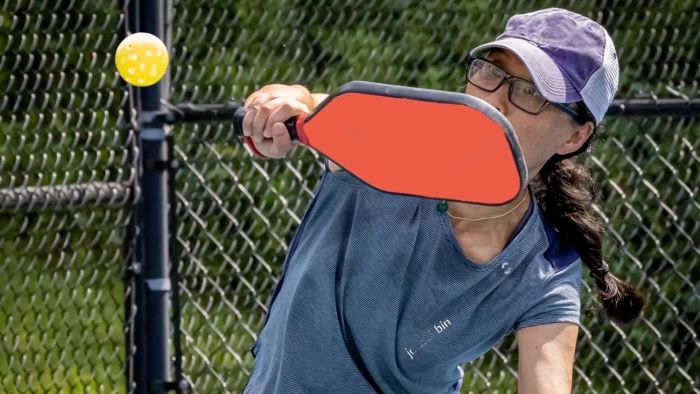
In this blog post, we’ll dive into precisely what volleys are in pickleball and why they matter so much. So grab your paddle, and let’s get started!
What Is a Volley in Pickleball?
Volley in pickleball is a type of shot where the player hits the ball without letting it bounce. A player usually does this at the net after serving or returning the opponent’s shot. The volley can keep an opponent on their toes and set up other shots, such as dinks and lobs.
Using the volley as a defensive technique can prevent opponents from gaining good positioning for their next shot. Proper technique is vital for successful volleys; players must use quick footwork and have an accurate aim to make successful volleys that will not give away points.
Types of Pickleball Volleys
One of the more essential skills when playing pickleball is effectively volleying the ball: back and forth between players.
The type of volley used depends on the situation and player preference. The most common type of volley is a forehand volley, which involves hitting the ball with an open-face racquet from your dominant hand in front of your body. Other volleys include backhand, drop, overhead, lobs, dinks (or “touch shots”), and defensive shots like blocks or slices.
Using different types of Pickleball volleys will make you a much better player overall, as it allows you to control where you hit the ball on your opponent’s side rather than just hitting it back randomly across the court.
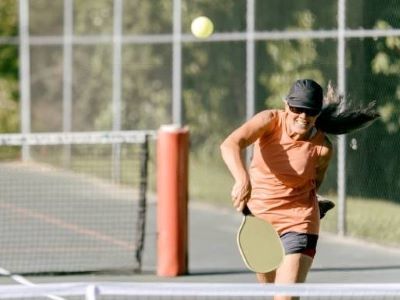
Punch Volley
Punch volley in pickleball is a shot to keep the ball low and close to the net. When an opponent hits a high ball, it isn’t easy to reach up and return it with a standard volley.
The punch volley involves hitting the ball with an angled swing rather than straight on, which keeps the shot’s trajectory low and close to the ground. While returning shots hit close to or over their heads, players can remain near their baseline.
As an offensive tool, punch volleys allow players to play aggressively at the net without having to leave their feet every time they return a shot.
Roll Volley
Roll volley in pickleball is a technique that involves hitting the ball with an open paddle as it rolls over the net. Using it, you can create a fast-paced rally by returning a shot quickly from an opponent.
The Roll volley requires players to have quick reflexes, good hand-eye coordination, and timing. It involves putting a spin on the ball while it is still rolling so that it will continue moving forward after bouncing off your paddle. This technique can also be offensive to catch your opponent off guard and score points more quickly.
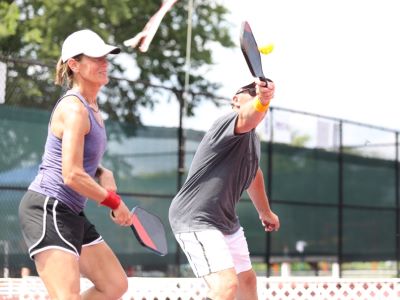
Drop Volley
Pickleball’s drop volley is a shot that quickly returns the ball. It involves keeping the paddle close to the net, making contact with the ball as soon as it crosses over, and then gently dropping it back onto your opponent’s side.
This shot can be very effective and help keep your opponents on their toes. It requires good timing, technique, and precision to succeed, but if done well, it can give you an advantage during a game.
Dink Volley
Pickleball dink volleys are close-range shots. It keeps the ball in play and prevents an opponent from scoring a point. The player will hit the ball softly with their paddle, usually just over the net, so it drops barely on their side of the court.
This type of shot you can use defensively to prevent an opponent from making a winning shot or offensively to set up for another powerful stroke, such as a spike or lob. Dink volleys are essential for competitive pickleball; mastering this technique can give players an advantage over their opponents.
Ways to Hit the Volley in Pickleball
Pickleball is a fast-paced game that requires quick reflexes and good strategy to be successful. Hitting the volley in pickleball can be difficult, but it becomes easier with practice and the proper techniques. Here are some tips on how to hit the volley in pickleball:
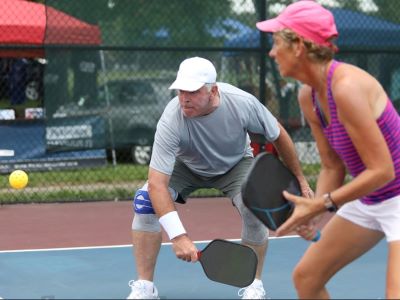
- Ensure Your Feet Are Set: A proper stance will give you more control over your shots, allowing you to react quickly to incoming shots. You should have one foot slightly forward for balance and ensure both feet are firmly planted on the ground before swinging at the ball.
- Keep Your Racket Up: Keeping your racquet up as soon as possible after making contact with the ball will help ensure you get enough power behind each shot while giving you more control when returning volleys across the net.
- Get Low: Getting down low will help you generate more power behind each shot while making it easier to reach incoming volleys quicker than if you were standing upright or hunched over too much during play.
- Practice Anticipating Where Shots Might Come From: Knowing where an opponent’s shot is likely going can help give players an edge when attempting a problematic return volley or when trying to position themselves correctly for their next shot to gain an advantage over their opponent during play.
- Use Spin Correctly: Spin can significantly enhance a player’s ability when hitting volleys, so learn how to use spin correctly, as this could prove helpful in many situations during gameplay.
Players can improve their volleys and become more successful in pickleball by following these tips. With practice and dedication, anyone can become a great pickleball player.
How to Score Volley in Pickleball?
Volley is when a player returns the ball without letting it bounce on their side of the court. To score a volley in pickleball, the player must hit the ball over the net and into their opponent’s court before they have time to react or return it.
They will only score a point if they hit it over the net. The first team to score 11 points wins, and at least two points must separate them from their opponents (e.g., 11-9). If both teams reach 10 points each, play continues until one team has two more than its opponent (e.g., 15-13). Serving alternates between teams after every two points scored until someone reaches 11 points and wins – so practice your serve!
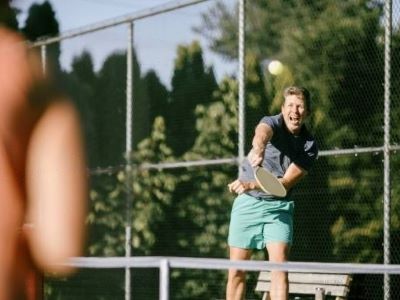
Can You Volley in the Kitchen Line?
One unique game feature is the kitchen line, an imaginary boundary at the non-volley zone. Players must stay behind this line when volleying or risk losing points for their team. The question then becomes: Can you volley in the kitchen line in pickleball?
The short answer is “No“; players cannot cross into the non-volley zone to make a volley shot. In this case, they will lose any points earned from that shot and possibly incur further penalties depending on where they hit it from and how long it remained before being served again. To play competitively, one should avoid volleying near or over the kitchen line, which is against pickleball rules.
As a result, pickleball does not allow volleying in the kitchen line. Players must respect the boundaries of the non-volley zone and stay behind it when making shots. Doing so will ensure they abide by the game’s rules and avoid any penalties for crossing into this prohibited area.
Mistakes to Avoid While Playing Volley
Pickleball is a fun and physically demanding sport that can be enjoyed by both experienced players and beginners alike. However, there are some mistakes to avoid while playing the volley shot in pickleball.
First, when returning a volley shot, it is essential to keep your eye on the ball until you make contact with it. It will allow you to adjust your swing and ensure you hit the ball accurately. Additionally, try to take your time with your swing, as this can lead to off-target shots and errors in judgment of where the ball is going.
Second, do not overhit or put too much power behind each shot, as this could send the ball out of bounds or make it difficult for your opponent to return their shot. Instead, focus on accuracy over power when hitting volleys so that each shot stays within bounds and allows for an easy return from your opponent’s courtside.
Finally, be mindful of where other players are standing on the court when hitting volleys. It could cause interference or unintentional physical contact with other players leading to injury or penalties being called against you. Ensure sufficient space between yourself and other players before swinging at a volley so that everyone remains safe during playtime!
By following these tips and avoiding the mistakes mentioned, players can enjoy a safe and enjoyable pickleball game without compromising their performance.
Ways to Improve Volley in Pickleball
In recent years, pickleball has become increasingly popular, especially among seniors. Its slower pace and smaller court size make it easier for those with less mobility or agility to play. Improving your volley game can help you stay competitive at the pickleball court, no matter your age or skill level. Here are some ways to improve your volley skills:
- Practice Your Footwork: Moving quickly and efficiently is one of the most important aspects of playing pickleball well. It’s essential to practice proper footwork when moving around the court so you can reach shots that come near the net more easily.
- Work on Your Hand-Eye Coordination: Good hand-eye coordination is essential for taking successful volleys at pickleball since you’ll need a quick reaction time to hit the ball accurately before it bounces twice on your side of the court. Working on this skill can help improve your volley significantly.
- Learn Proper Volley Technique: How to properly hold and swing a paddle when volleying can give you better control over where you place shots and make it harder for opponents to return successfully. When hitting a volley, you follow through with your arm until it points toward where you want the ball to go while keeping your elbow up near shoulder height during contact.
- Focus On Placement: When practicing volleys, focus more on placement rather than power, as this will increase accuracy and give opponents less time to react and return shots over the net successfully.
- Develop A Consistent Serve: A consistent serve will allow you to stay in control of the point and set up volleys more easily. Practicing your serves regularly can help with this and give your opponents fewer chances to hit robust returns over the net.
By improving these skills and focusing on proper technique, you’ll be able to take successful volleys more often at pickleball and become a better player overall!
FAQs
The “No Volley” zone has tight guidelines to ensure that everyone knows what they can and cannot do. A few aspects of Pickleball’s kitchen play are made more apparent by the over-the-line (OTT) rule, such as that players should never volley with their feet on the line because doing so would result in a fault.
The main difference between a volley and a rally in pickleball is that a volley is when both players hit the ball before it bounces, while a rally is when the ball bounces at least once before one player hits it. A volley involves faster, more powerful shots back and forth, while rallies involve more technical play as players must adjust their shots to account for the ball’s bounce.
The court area within 7 feet on either side of net two is known as the non-volley zone. The non-volley zone is off-limits to volleying. Players are not permitted to execute smashes from a position inside zone 3 due to this rule.
Conclusion
Volley in Pickleball is an essential part of the game. With it, the ball would fly all over the court, and Pickleball would be more enjoyable and challenging. Players must have good volleying skills to set up blocks and make shots on defense. By learning how to volley, players can improve their overall game and have more fun playing Pickleball.
The key is to practice, to play, and to practice. We’ll see you on the court!

I am the founder of BallSportsPro, a popular pickleball resource for players of all levels. I am a former professional tennis player, started playing pickleball in 2009 and quickly fell in love with the game. I launched BallSportsPro in 2018 to share my passion for the sport and to provide pickleball players with the latest news, tips, and gear reviews. Today, BallSportsPro is one of the most popular pickleball resources on the web, reaching hundreds of thousands of players each month. In addition to running the website, I also a regular contributor to Pickleball Magazine and a member of the USAPA Pickleball Ambassadors program.




